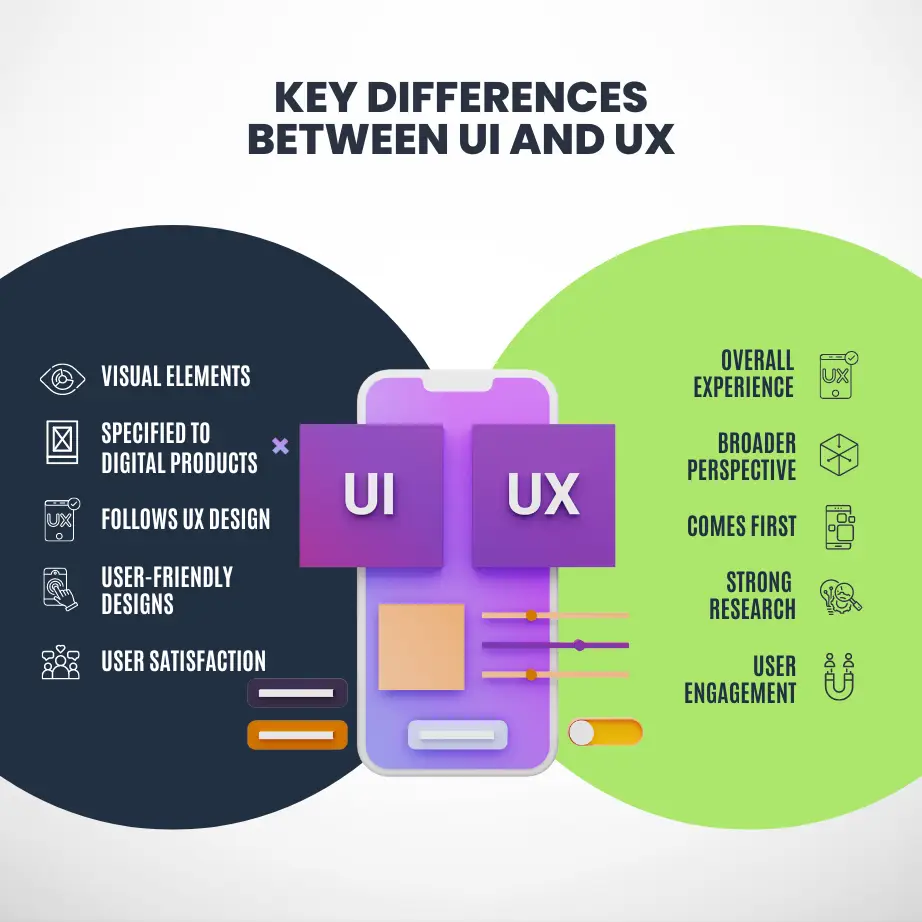The importance of UI or UX in mobile app development can’t be ignored, as these components play an equally important role in developing a mobile app from scratch. Without careful consideration of UX and UI, mobile apps risk not offering a satisfying user experience and not drawing in new users.
In today’s blog, we will learn the significance of UI/UX development and quickly compare the two. Let us find out what’s more important in building a mobile app or if both play equally important roles. By examining their essential roles and features in depth at every step, businesses can get clarity on their critical components if they are beginning a new app development project.
What is UI?
It’s a tricky question! Well-designed apps are the ones that customers enjoy using, and that success is a shared responsibility of UX design and UI design.
UX (user experience design) and UI (user interface design) are like siblings in the app design process – interconnected but each with its own unique focus. While UX is centered on how users interact with the product, UI focuses on the visual appeal and layout.
Both UI and UX are crucial, and instead of choosing one over the other, we’ll highlight the importance of each.
UX vs. UI Design: The Definitions
User experience (UX) design handles every aspect of how users interact with the product. The goal of UX design is to create products that are functional, user-friendly, and enjoyable to use.
To achieve this, UX designers need a deep understanding of design, human behavior, and psychology. They often conduct user research, interviews, and testing to understand their target audience, their needs, and preferences.
The User Interface (UI) is abbreviated as UI. Essentially, it’s how you use a device or software. This comprises all the visual elements you see on the screen, such as text, menus, buttons, and icons. A well-designed UI ought to be simple to use and comprehend. The user interface (UI) is how you instruct a machine. This may entail utilizing touch gestures on a phone screen, typing on a keyboard, or clicking buttons.
UI design is more than just practical design. It also involves making an aesthetically pleasing experience and making it easy to utilize. In short, UI is about creating a smooth and enjoyable user experience when interacting with a device.
Importance of UI In Android App Development
- Usability: A decent UI makes the program simple and intuitive to use. Users should not have to spend time learning how to perform things. The layout, menus, and buttons should be logical and consistent.
- User Engagement: A visually appealing and engaging UI can keep users returning for more. This is especially critical in a competitive mobile app market, where customers have numerous options.
- Brand identification: The UI is essential to an app’s brand identification. It should be visually appealing and consistent with the app’s overall brand messaging.
- Positive First Impression: Users form opinions about apps within seconds of opening them. A poor user interface can create an unfavorable initial impression that isn’t easy to overcome.
- Increased User Retention: A well-designed user interface can reduce user annoyance and improve user retention rates. Users are more inclined to continue with apps that are simple and pleasurable to use.
- Better Customer Satisfaction: Finally, a decent UI increases customer satisfaction. Users who have had a good experience with an app are more inclined to suggest it to others.
What is UX?
User interface (UI) design, on the other hand, focuses on the visual aspects of a product, including color palettes, typography, layout, and overall aesthetics. In UI/UX design, the role of online user interface design is to create a visually appealing, intuitive, and cohesive experience for users.
UI design integrates aesthetics with usability to reduce cognitive load, ensure consistency across visual elements, and make products enjoyable to use. The difference between UX and UI lies in their focus: while UX improves the functionality and experience, UI enhances the visual interaction.
Interestingly, when UI and UX design are executed well, the online user interface becomes nearly invisible—every icon, button, and graphic flows seamlessly, guiding users smoothly to their goals without distraction. From the user’s perspective, it just works.
UX (User Experience) refers to a person’s total experience when interacting with a product, service, or even a corporation. It covers everything from how simple it is to use to how enjoyable it is to interact with. UX design prioritizes the user’s wants and emotions throughout the encounter. This includes everything from the first impression to long-term use.
Good UX can increase customer pleasure, brand loyalty, and reputation. A well-thought-out, pleasurable product will probably be adopted and used frequently.
Conversely, poor UX can cause annoyance, perplexity, and desertion. Users are prone to quit a product if it is hard to use or comprehend.
Importance of UX In Android App Development
- Content Users, Faithful Users: A well-designed user experience (UX) produces an intuitive, pleasurable experience. This results in satisfied users who are more inclined to use your app consistently and stay.
- Boosts Retention and Engagement: User-friendly UX makes apps more straightforward to use and navigate, which keeps users interested. Users can find what they need quickly and complete activities swiftly, which results in them using the app longer. This results in higher retention rates, which are a crucial app success statistic.
- Positive reviews from user experience: Users are more inclined to promote the app to others and write favorable reviews when they have a good experience. The natural advertising that comes from word-of-mouth can significantly boost app growth and downloads.
- Benefits to the company: In the end, a good user experience benefits the company. Increased in-app purchases, advertising revenue, and overall app success are all correlated with increased user satisfaction and retention.
UI/UX: Key Differences
It’s needless to compare UI/UX in app development as both play their essential role simultaneously. Moreover, any mobile app’s success depends on how well they work together. This raises a serious question.
Why are we even comparing the two?
Indeed, for those who consider them the same. UI is your mobile app’s appearance, whereas UX is how it acts correctly. EasyEasy navigation, smooth information loading, and timely notifications are some examples. Let’s find out what are some of the significant differences between the two in detail:

Major Focus
UX: Overall experience
UX design focuses on the complete user experience when interacting with a product or service. It takes into account user emotions, information architecture, usability, and ease of use.
UI: Visual elements
The appearance and feel of the interface that users directly interact with are the main focus of UI design. Screens, buttons, menus, typefaces, icons, and color schemes are all included in this.
Scope
UX: A broader perspective
UX design takes a comprehensive approach to the product or service. It considers the user’s wants, objectives, and problems at every touchpoint.
UI: Specified for digital products
UI design focuses on websites, applications, and software interfaces. Although UI can influence user experience in physical products, UX design has a more significant impact there.
Tools and products
UX: Sitemaps, wireframes, user flows, reports on user research, and prototypes. To comprehend user needs, UX designers mostly rely on user research techniques, including surveys, interviews, and usability testing.
UI: Style manuals, high-fidelity prototypes, and mockups. UI designers use applications like Adobe XD, Sketch, or Figma to build visually appealing interfaces.
Process and timeline
UX: Comes first
Usually, it occurs first during the design phase. Before introducing UI elements, UX designers research, test, and iterate on the key capabilities and user flows.
UI: Follows UX design
Adheres to UX design. UI designers develop the user-interactive visual layer after the UX foundation.
Skills and expertise
UX: Strong research
I need a solid grasp of interaction design, information architecture, and user psychology. Empathy, problem-solving, and research are among UX designers’ strong suits.
UI: User-friendly designs
It requires knowledge of layout, typography, color theory, animation, and visual design principles. UI designers are frequently artistically oriented and have a strong sense of aesthetics and user-friendliness.
Criteria for success
UX: User engagement
It focuses on measures that gauge task completion rates, user happiness, mistake rates, and ease of use.
UI: User satisfaction
User engagement measures include time spent on a page, click-through rates, and how effectively users understand the visual cues.
Discovering the harmony between UX and UI
As we have already discussed, debating between UI/UX regarding superiority is unrequired as both work together through various stages while developing a next-generation mobile application. An appealing user interface (UI) creates the foundation for a satisfying user experience, but a well-designed UX guarantees that the program is operating as intended. In perfect sync, they concentrate on essential elements such as regularity, user-generated feedback, user-centered designs, and any mobile application’s overall look and feel.
Conclusion
Concluding today’s blog, we can agree that there is no comparison between UI and UX as both are key players in developing a superior mobile app. Although knowing the critical difference between the two can be significant, picking out the best one is undoubtedly useless. Developers must stay abreast of the latest design trends and user preferences as technology advances to create successful and durable mobile applications.
Finding a top UI/UX Design and Development Company is not only a smart investment for any app development project but also a strategic need in a world where an application’s user experience may make or destroy it. Want to stay ahead in your projects? Get in touch!
FAQs-UX or UI: What’s More Important In App Development
What is the difference between UX and UI in app development?
UX (User Experience) focuses on the overall feel of the app and how users interact with it. It involves research, prototyping, and testing to ensure the app is user-friendly and meets user needs. UI (User Interface), on the other hand, deals with the visual aspects of the app, such as design, layout, and interactive elements. It’s about making the app visually appealing and ensuring that the interface guides users effectively.
Why is UX important in app development?
UX is crucial because it ensures that the app is easy to use, efficient, and enjoyable for users. A well-designed UX leads to higher user satisfaction, increased engagement, and better retention rates. If users find the app difficult or frustrating to use, they are likely to abandon it, regardless of how visually appealing it is.
How does UI impact the success of an app?
UI impacts the success of an app by creating an attractive and intuitive interface that captures users’ attention and keeps them engaged. A good UI makes the app visually appealing, easy to navigate, and helps establish a brand’s identity. Poor UI can make an app look unprofessional and deter users from using it.
Can an app succeed with great UX but poor UI, or vice versa?
While it’s possible for an app to have great UX but poor UI, or vice versa, the best apps excel in both areas. Great UX ensures the app is functional and meets user needs, while great UI makes the app appealing and easy to navigate. Both elements are interdependent, and balancing them is key to developing a successful app. Prioritizing one over the other can lead to an incomplete and less effective user experience.



